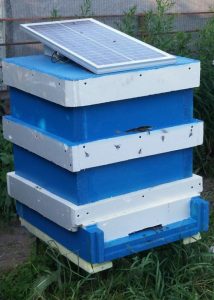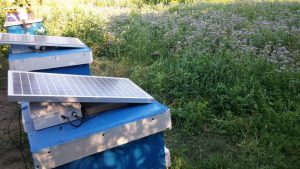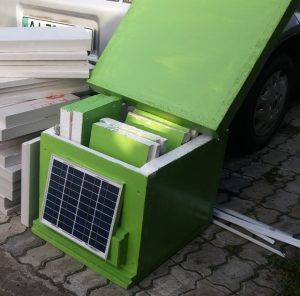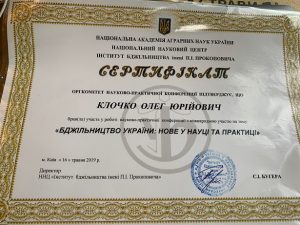- Our IT apiary is becoming increasingly popular, especially among domestic universities.
AmoHive and the Volodymyr Dahl East Ukrainian National University have signed a joint memorandum to begin scientific and research work using AmoHive’s IT apiary. This collaboration will cover a wide range of scientific research, including the creation of semi-automatic smart beehives, prototypes of electromagnetic devices to combat the Varroa destructor, and data processing using Data Science methods. A key focus is the development of a knowledge base that combines beekeeping, microprocessor technology, electronics, telecommunications, and software.
- On 1 June 2023, the first IT apiary in Ukraine was opened near Kyiv, Ukraine, on International Children’s Day.
The IT apiary consists of 10 identical AmoHive smart hives.
Alongside the opening of the IT apiary, several unique research studies were launched:
1. A study comparing the development of the three most popular bee races in Ukraine: Carniolan honey bee , Apis mellifera sossimai and Apis mellifera carpatica .
2. The collection and analysis of relational data from bee colonies during spring development and honey collection (from acacia, rapeseed, buckwheat, sunflower, etc.).
3. The collection and analysis of relational data on the swarming behavior of different bee races, the creation of new wintering methods adapted to climate change, and other studies to optimize IoT functionality in smart hives.
Additionally, we are excited to announce the creation of a lecture course for Ukrainian children that combines knowledge of electronics, programming, and beekeeping into a single preparatory course.
We invite universities and colleges to cooperate with us.
TV Reports:
AmoHive RADA TV AmoHive Kyiv 24 AmoHive Suspilne Culture
- Smart hive knows everything about the Carpathian bee!
- “Government Courier” learned how to use modern technologies in a family apiary in Transcarpathia.

- We took part in the “International IT Forum 2019. Digital future“, where the concept of the project “Digital Agenda of Ukraine – 2020” was presented. The АмоHive and small model of the AmoHive, which was created to teach children to “Beekeeping and Information Technology” were successfully presented.More about Digitalization in Ukraine and Ukrainian Digital News
- In early spring, the Pear and Cornus trees were pollinated by bees. These are quite rare fruit trees, but they also need to be pollinated by bees in the spring.
- Scientific Conference in Kyiv, Ukraine. Our partner in Ukraine, Oleg Klochko, took part in the scientific conference of beekeeping. This conference was held at the HSC Institute of Beekeeping named P.I. Prokopovich. Who is mr. “Prokopovich”? Qui est monsieur “Prokopovich”?
“…Ukrainian beekeeper Prokopovych studied the biology of bee colonies and strove to improve existing methods of beekeeping. His main intention was to develop methods that allowed the least disturbance and damage to bees. ..These efforts resulted in 1814 in the invention of the world’s first frame hive, which allowed an easier honey harvest. Another invention was a wooden partition with apertures passable only by worker bees, now called a queen excluder. It made possible the harvest of pure honey from the frames. Prokopovych’s inventions represented a landmark in the history of beekeeping and marked the beginning of commercial beekeeping…..”
- April 2019. Our hives are testing.
This time our hive was lested by a breeding queen company. Let me introduce: Family Apiary “Lendel”, Mrs. Maria Lendel. The apiary are specializing in production good quality queens of the APIS MELLIFERA CARPATICA.
We have equipped the hive with additional sensors necessary for the successful control of the production of quality Queen bees. The Apiary have been designed in the traditional and history of beekeeping style.
Please, look at these stylish beehives!
- March-April 2019.
We have given our Amohive to one of the best video bloggers in beekeeping, Mr. Adrey Baskevith. He have recorded film about our hive, which has ben collected more than 80,000 views for the 4 weeks!
As a result, we received a lot of contacts, an orders for delivery our AmoHives, as well, and many interesting suggestions and ideas!
Our beehives will go to the USA, Europe, Israel, Canada, and of course Ukraine and Poland!
- August 2018. Effects of Pollination early Spring:
- July 2018. Borago and Sunflowers Honey.
Wikipedia about Borage,
Borage Honey,
ALL ABOUT BORAGE,
Wiki about Helianthus,
Sunflower honey,
History…. Prototype N1. and 2. May 2016:


AmoHive.”First” and “Second”.
Amohive in Ukraine. Jun 2016
Preparing for spring 2017:















































